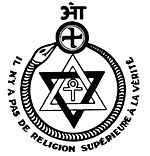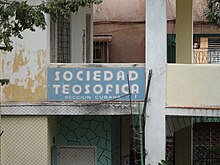Theosophical Society
This article may be expanded with text translated from the corresponding article in German. (November 2017) Click [show] for important translation instructions.
|
| Part of a series on |
| Theosophy |
|---|
 |
Topics Theosophical Society Founders
Theosophists
Theosophical philosophical concepts
Theosophical organizations
Theosophical texts
Theosophical publications
Theosophical Masters
Comparative Theosophy
Related topics
|
|
| Part of a series on |
| Spirituality |
|---|
|
Religion
|
Traditional
|
Modern
|
Spiritual experience
|
Spiritual development
|
Influences |
Western General
Antiquity
Medieval
Early modern
Modern
|
Orientalist
|
Asian Pre-historic
Iran
India
East-Asia
|
Other non-western
|
Psychological
|
Research |
Neurological
|
|
The Theosophical Society was an organization formed in 1875 by Helena Blavatsky to advance Theosophy. The original organization, after splits and realignments, currently[update] has several successors.[1] Following the death of Blavatsky, competition within the Society between factions emerged, particularly among founding members and the organisation split between the Theosophical Society Adyar (Olcott-Besant) and the Theosophical Society Pasadena (Judge). The former group, headquartered in India, is the most widespread international group holding the name "Theosophical Society" today.
Contents
1 History
1.1 Formation
1.2 The Hidden Masters
1.3 Schisms
2 The "World Teacher"
2.1 Jiddu Krishnamurti
3 Related individuals and organizations
4 See also
5 References
6 External links
History
Formation

Notes of the meeting proposing the formation of the Theosophical Society, New York City, 8 September 1875

The Society's seal incorporated the Swastika, Star of David, Ankh, Aum and Ouroboros symbols.
The Theosophical Society was officially formed in New York City, United States, on 17 November 1875 by Helena Petrovna Blavatsky, Colonel Henry Steel Olcott, William Quan Judge, and others. It was self-described as "an unsectarian body of seekers after Truth, who endeavour to promote Brotherhood and strive to serve humanity." Olcott was its first president, and remained president until his demise in 1907. In the early months of 1875, Olcott and Judge had come to realize that, if Blavatsky was a spiritualist, she was no ordinary one.[2] The society's initial objective was the "study and elucidation of Occultism, the Cabala etc."[3] After a few years Olcott and Blavatsky moved to India and established the International Headquarters at Adyar, in Madras (now Chennai). They were also interested in studying Eastern religions, and these were included in the Society's agenda.[4] After several iterations the Society's objectives evolved to be:
.mw-parser-output .templatequote{overflow:hidden;margin:1em 0;padding:0 40px}.mw-parser-output .templatequote .templatequotecite{line-height:1.5em;text-align:left;padding-left:1.6em;margin-top:0}
- To form a nucleus of the universal brotherhood of humanity without distinction of race, creed, sex, caste, or colour.
- To encourage the study of comparative religion, philosophy, and science.
- To investigate the unexplained laws of nature and the powers latent in man.
Sympathy with the above objects was the sole condition of admission to the society. The Society was organized as a non-sectarian entity. The following was stated in the Constitution and Rules of the Theosophical Society
ARTICLE I: Constitution
4. The Theosophical Society is absolutely unsectarian, and no assent to any formula of belief, faith or creed shall be required as a qualification of membership; but every applicant and member must lie in sympathy with the effort to create the nucleus of an Universal Brotherhood of Humanity
[…]
ARTICLE XIII Offences
1. Any Fellow who shall in any way attempt to involve the Society in political disputes shall be immediately expelled.
2. No Fellow, Officer, or Council of the Theosophical Society, or of any Section or Branch thereof, shall promulgate or maintain any doctrin[e ]as being that advanced, or advocated by the Society.[5]
The Society reformulated this view in a resolution passed by the General Council of the Theosophical Society on December 23, 1924.[6]

Seal of the Theosophical Society, Budapest, Hungary
The Hidden Masters
One of the central philosophical tenets promoted by the Society was the complex doctrine of The Intelligent Evolution of All Existence, occurring on a cosmic scale, incorporating both the physical and non-physical aspects of the known and unknown Universe, and affecting all of its constituent parts regardless of apparent size or importance. The theory was originally promulgated in the Secret Doctrine, the 1888 magnum opus of Helena Blavatsky.[7] According to this view, humanity's evolution on earth (and beyond) is part of the overall cosmic evolution. It is overseen by a hidden spiritual hierarchy, the so-called Masters of the Ancient Wisdom, whose upper echelons consist of advanced spiritual beings.
Blavatsky portrayed the Theosophical Society as being part of one of many attempts throughout the millennia by this hidden Hierarchy to guide humanity – in concert with the overall intelligent cosmic evolutionary scheme – towards its ultimate, immutable evolutionary objective: the attainment of perfection and the conscious, willing participation in the evolutionary process. These attempts require an earthly infrastructure (such as the Theosophical Society) which she held was ultimately under the inspiration of a number of Mahatmas, members of the Hierarchy.[8]
Schisms

Main building of the Theosophical Society in Adyar, India, 1890
After Helena Blavatsky's death in 1891, the Society's leaders seemed at first to work together peacefully. This did not last long. Judge was accused by Olcott and then prominent Theosophist Annie Besant of forging letters from the Mahatmas; he ended his association with Olcott and Besant in 1895 and took most of the Society's American Section with him. The original organisation led by Olcott and Besant remains today based in India and is known as the Theosophical Society – Adyar. The group led by Judge further splintered into a faction led by Katherine Tingley, and another associated with Judge's secretary Ernest Temple Hargrove. While Hargrove's faction no longer survives, the faction led by Tingley is today known as the Theosophical Society with the clarifying statement, "International Headquarters, Pasadena, California". A third organization, the United Lodge of Theosophists or ULT, in 1909 split off from the latter organization.
In 1902, Rudolf Steiner became General Secretary of the German-Austrian division of the Theosophical Society. He maintained a Western-oriented course, relatively independent from the Adyar headquarters.[9][10] After serious philosophical conflicts with Annie Besant and other members of the international leadership on the spiritual significance of Christ and on the status of the young boy Jiddu Krishnamurti (see section below), most of the German and Austrian members split off in 1913 and formed the Anthroposophical Society. The latter remains active today and has branches in several countries, including the US and Canada.
The English headquarters of the Theosophical Society are at 50 Gloucester Place, London. The Theosophical Society in Ireland [3], based in Pembroke Road, Dublin, is a wholly independent organisation which claims to have received its charter directly from Helena Blavatsky. The original group contained (among others) George William Russell (A. E.) poet and mystic, and the leadership role later fell to Russell's friend P. G. Bowen, (author and teacher of practical occultism) and later still to Bowen's long time student Dorothy Emerson. The current leadership of this group were students of Emerson. The independent Dublin organisation should not be confused with a similarly named group affiliated to Adyar which is based in Belfast but claims an all-Ireland jurisdiction.
The "World Teacher"

Theosophical Society, Basavanagudi, Bangalore
In addition to the stated objectives, as early as 1889 Blavatsky publicly declared that the purpose of establishing the Society was to prepare humanity for the reception of a World Teacher: according to the Theosophical doctrine described above, a manifested aspect of an advanced spiritual entity (the Maitreya) that periodically appears on Earth in order to direct the evolution of humankind. The mission of these reputedly regularly appearing emissaries is to practically translate, in a way and language understood by contemporary humanity, the knowledge required to propel it to a higher evolutionary stage.
If the present attempt, in the form of our Society, succeeds better than its predecessors have done, then it will be in existence as an organized, living and healthy body when the time comes for the effort of the XXth century. The general condition of men's minds and hearts will have been improved and purified by the spread of its teachings, and, as I have said, their prejudices and dogmatic illusions will have been, to some extent at least, removed. Not only so, but besides a large and accessible literature ready to men's hands, the next impulse will find a numerous and united body of people ready to welcome the new torch-bearer of Truth. He will find the minds of men prepared for his message, a language ready for him in which to clothe the new truths he brings, an organization awaiting his arrival, which will remove the merely mechanical, material obstacles and difficulties from his path. Think how much one, to whom such an opportunity is given, could accomplish. Measure it by comparison with what the Theosophical Society actually has achieved in the last fourteen years, without any of these advantages and surrounded by hosts of hindrances which would not hamper the new leader.[11]
This was repeated by then prominent Theosophist Annie Besant in 1896, five years after Blavatsky's death.[12] Besant, who became President of the Society in 1907, thought the appearance of the World Teacher would happen sooner than the time-frame in Blavatsky's writings, who had indicated that it would not take place until the last quarter of the 20th century.[13]
Jiddu Krishnamurti
One of the people who expected the imminent reappearance of the Maitreya as World Teacher was Charles Webster Leadbeater, then an influential Theosophist and occultist. In 1909 he "discovered" Jiddu Krishnamurti, an adolescent Indian boy, who he proclaimed as the most suitable candidate for the "vehicle" of the World Teacher.[14][15] Krishnamurti's family had relocated next to the Theosophical Society headquarters in Adyar, India, a few months earlier.[16] Following his "discovery", Krishnamurti was taken under the wing of the Society, and was extensively groomed in preparation for his expected mission.
However, by 1925 Krishnamurti had begun to move away from the course expected of him by the leaders of the Theosophical Society Adyar and by many Theosophists. In 1929 he publicly dissolved the Order of the Star, a worldwide organization created by the leadership of the Theosophical Society to prepare the world for the Coming of the Maitreya, and abandoned his assumed role as the "vehicle" for the World Teacher.[17] He eventually left the Theosophical Society altogether, yet remained on friendly terms with individual members of the Society.[18] He spent the rest of his life traveling the world as an independent speaker, becoming widely known as an original thinker on spiritual, philosophical, and psychological subjects.
Related individuals and organizations

Commemorative plaque of Theosophical Society, Adyar, India
The following have been at many times associated, or have claimed association, with the original Theosophical Society, its philosophy, leaders, branches, or descendant organizations. Listed alphabetically.

Theosophical Society, Havana, Cuba, March 2014
- Agni Yoga
- Ananda College
- Anthroposophy
- Alice Bailey
- Andrei Bely
- Ascended Master Teachings
- The Bridge to Freedom
- Benjamin Creme
Buddhist Theosophical Society (of Ceylon)- Brother XII
- Church Universal and Triumphant
- C.W. Leadbeater
- Elizabeth Clare Prophet
- James Cousins
- Halcyon, California
- Cora Linn Daniels
- Hugh Dowding
Thomas Edison[citation needed]
- "I AM" Activity
- Wassily Kandinsky
- The Summit Lighthouse
- Anna Kingsford
- Liberal Catholic Church
- Order of the Temple of the Rosy Cross
- Nilakanta Sri Ram
- Jorge Ángel Livraga Rizzi
- Nicholas Roerich
- Schola Philosophicae Initiationis
- Alexander Scriabin
- Share International
- Victor Skumin
- Vladimir Solovyov
- The Word Foundation
See also
- Annie Besant
- Aryan race – Theosophy
- Ascended Masters
- Charles Webster Leadbeater
- G R S Mead
- Harold W Percival
- Helena Blavatsky
- Jiddu Krishnamurti
- Religion and mythology
- Rerikhism
- Rudolf Steiner
- Theosophical mysticism
- William Quan Judge
References
^ Melton, Gordon J. (Sr. ed.) (1990). "Theosophical Society". New Age Encyclopedia. Farmington Hills, Michigan: Gale Research. pp. 458–461. .mw-parser-output cite.citation{font-style:inherit}.mw-parser-output q{quotes:"""""""'""'"}.mw-parser-output code.cs1-code{color:inherit;background:inherit;border:inherit;padding:inherit}.mw-parser-output .cs1-lock-free a{background:url("//upload.wikimedia.org/wikipedia/commons/thumb/6/65/Lock-green.svg/9px-Lock-green.svg.png")no-repeat;background-position:right .1em center}.mw-parser-output .cs1-lock-limited a,.mw-parser-output .cs1-lock-registration a{background:url("//upload.wikimedia.org/wikipedia/commons/thumb/d/d6/Lock-gray-alt-2.svg/9px-Lock-gray-alt-2.svg.png")no-repeat;background-position:right .1em center}.mw-parser-output .cs1-lock-subscription a{background:url("//upload.wikimedia.org/wikipedia/commons/thumb/a/aa/Lock-red-alt-2.svg/9px-Lock-red-alt-2.svg.png")no-repeat;background-position:right .1em center}.mw-parser-output .cs1-subscription,.mw-parser-output .cs1-registration{color:#555}.mw-parser-output .cs1-subscription span,.mw-parser-output .cs1-registration span{border-bottom:1px dotted;cursor:help}.mw-parser-output .cs1-hidden-error{display:none;font-size:100%}.mw-parser-output .cs1-visible-error{font-size:100%}.mw-parser-output .cs1-subscription,.mw-parser-output .cs1-registration,.mw-parser-output .cs1-format{font-size:95%}.mw-parser-output .cs1-kern-left,.mw-parser-output .cs1-kern-wl-left{padding-left:0.2em}.mw-parser-output .cs1-kern-right,.mw-parser-output .cs1-kern-wl-right{padding-right:0.2em}
ISBN 0-8103-7159-6. "No single organization or movement has contributed so many components to the New Age Movement as the Theosophical Society. ... It has been the major force in the dissemination of occult literature in the West in the twentieth century." In same, see sections "Theosophy" and "Theosophical Offshoots", pp. xxv–xxvi [in "Introductory Essay: An Overview of the New Age Movement"]. Note "Chronology of the New Age Movement" pp. xxxv–xxxviii in same work, starts with the formation of the Theosophical Society in 1875.
^ The Theosophical Movement 1875–1950, Cunningham Press, Los Angeles 1951.
^ See photographic reproduction of the notes to the meeting proposing the formation of the Theosophical Society, New York City, 8 September, in the image from Wikimedia Commons.
^ Kirby, W. F. (January 1885). "The Theosophical Society". Time XII (1): 47-55 (London: Swan Sonnenschein;
OCLC 228708807). Google Books Search retrieved 2011-01-12. Profile by the entomologist and folklorist William Forsell Kirby.
^ Olcott, H. S. (January 1891). "Constitution and Rules of the Theosophical Society". The Theosophist 12 (4): 65-72. (Adyar: Theosophical Publishing House).
ISSN 0040-5892. "As Revised in Session of the General Council, all the Sections being represented, at Adyar, December 27, 1890".
^ "About the TS" Archived 2011-05-14 at the Wayback Machine. [see section "Freedom of Thought"]. ts-adyar.org. Adyar: Theosophical Society Adyar. Retrieved 2011-01-11.
^ Blavatsky, Helena (1888). "The Three Postulates of the Secret Doctrine". The Secret Doctrine: The Synthesis of Science, Religion, and Philosophy. Vol. I: Cosmogenesis. London et al.: The Theosophical Publishing Company et al., 1888 (
OCLC 8129381), pp. 14–20 [in "Proem"]. Reprint Phoenix, Arizona: United Lodge of Theosophists, 2005. Electronic version retrieved 2011-01-29. "This electronic version of The Secret Doctrine follows the pagination and style of the A FACSIMILE OF THE ORIGINAL EDITION OF 1888" (webpage editor's description). Also in same, see "The pith and marrow of the Secret Doctrine". pp. 273–285 (in "Summing Up").
^ Blavatsky 1888. "Our Divine Instructors". The Secret Doctrine. Vol. II: Anthropogenesis, pp 365–378. Phoenix, Arizona: United Lodge of Theosophists, 2005. Retrieved 2011-01-29.
^ Rudolf Steiner's book Theosophy, An Introduction to Supersensible Knowledge of the World and the Destination of Man (published in German as Theosophie. Einführung in übersinnliche Welterkenntnis und Menschenbestimmung), first appeared in 1904 ([1]).
^ Rudolf Steiner, Theosophy of the Rosicrucian, lectures given in 1907 ([2]).
^ Blavatsky, Helena (1889). "The Future of the Theosophical Society". The Key to Theosophy. London: The Theosophical Publishing Company. pp. 304–307 [context at pp. 306-307. Emphasis in original].
OCLC 315695318. Wheaton, Maryland: Theosophy Library Online. Retrieved 2011-01-29. "Scanned Reproduction from a Photographic Reproduction of the Original Edition as First Issued at London, England: 1889".
^ Lutyens, Mary (1975). Krishnamurti: The Years of Awakening. New York: Farrar Straus and Giroux. p. 12.
ISBN 0-374-18222-1.
^ Blavatsky 1889 p. 306. Wheaton, Maryland: Theosophy Library Online. Blavatsky, Helena (1966). "Esoteric Instructions (EI): The Esoteric Section: Introduction by the Compiler". Collected Writings. Series. Volume XII. Wheaton, Illinois: Quest Books. pp. 478–511 [context at p. 492].
ISBN 978-0-8356-0228-0. Groningen, Netherlands: katinkahesselink.net. Links retrieved 2011-01-29.
^ Washington, Peter (1995) [Originally published 1993]. "Boys and Gods". Madame Blavatsy's Baboon: A History of the Mystics, Mediums, and Misfits Who Brought Spiritualism to America. New York: Schocken Books. Hardcover. pp. 126–144.
ISBN 978-0-8052-4125-9.
^ Lutyens pp. 20-21.
^ Lutyens p. 7.
^ Jiddu, Krishnamurti (1929). "Order of the Star Dissolution Speech". J. Krishnamurti Online. Krishnamurti Foundations. Retrieved 2010-04-27.
^ Lutyens pp. 276, 285. Krishnamurti left the Society in 1931; Lutyens considered the "last tie" severed with the death of Besant in 1933.
External links
- Theosophical Society Headquarters
- The Theosophical Society in England
- The Theosophical Society in America
A Modern Revival of Ancient Wisdom (PDF).
Beginnings of the Theosophical Society.
Blavatsky and The Theosophical Society.
FAQ on the Theosophical Movement.
Skeptics Dictionary: entry on Theosophy.
The Theosophical Network.
Kerala Theosophical Federation.
Theosophical Movement 1875–1950.
The Word Foundation, Inc.- The Theosophical Society in Ireland [4]